Research Method: Comparing Home and In-Center Hemodialysis for ESRD
VerifiedAdded on 2022/08/13
|6
|1148
|31
Report
AI Summary
This report presents a research method comparing home hemodialysis to in-center hemodialysis for individuals with End-Stage Renal Disease (ESRD). The study utilizes the PICOT framework to formulate a research question focusing on the effectiveness of home hemodialysis versus in-center hemodialysis in terms of survival and quality of life. The significance of the problem is highlighted by the increasing prevalence of ESRD and the need to evaluate different treatment modalities. The purpose of the review is to assess the efficacy of home dialysis, evaluate patient experiences, and recommend strategies to improve treatment decisions. The search strategy involved PubMed and CINAHL, using keywords like 'home dialysis' and 'quality of life'. A total of 6 papers were selected to answer the research question. The report emphasizes the importance of understanding the benefits and harms of each treatment modality to improve patient education and decision-making.
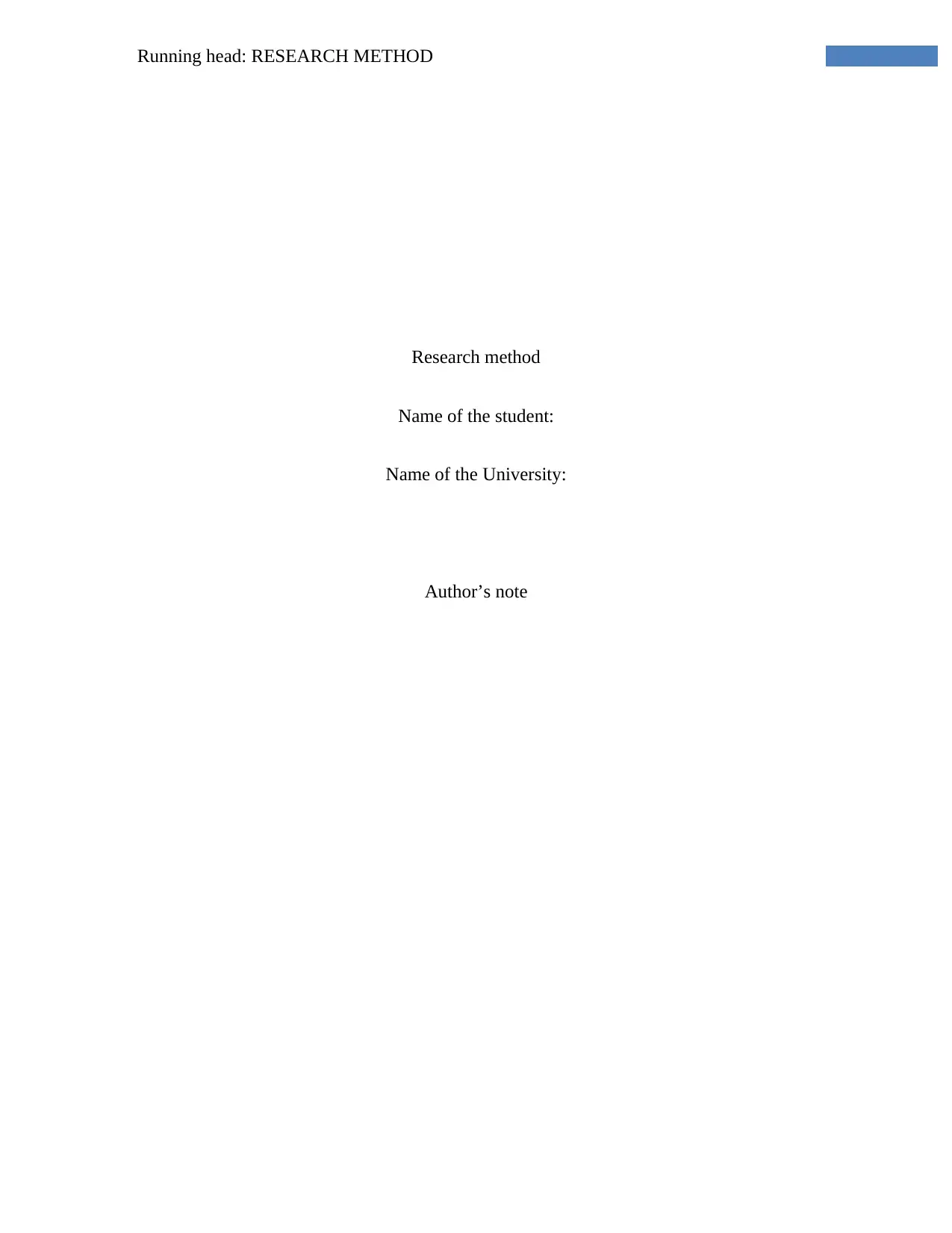
Running head: RESEARCH METHOD
Research method
Name of the student:
Name of the University:
Author’s note
Research method
Name of the student:
Name of the University:
Author’s note
Paraphrase This Document
Need a fresh take? Get an instant paraphrase of this document with our AI Paraphraser
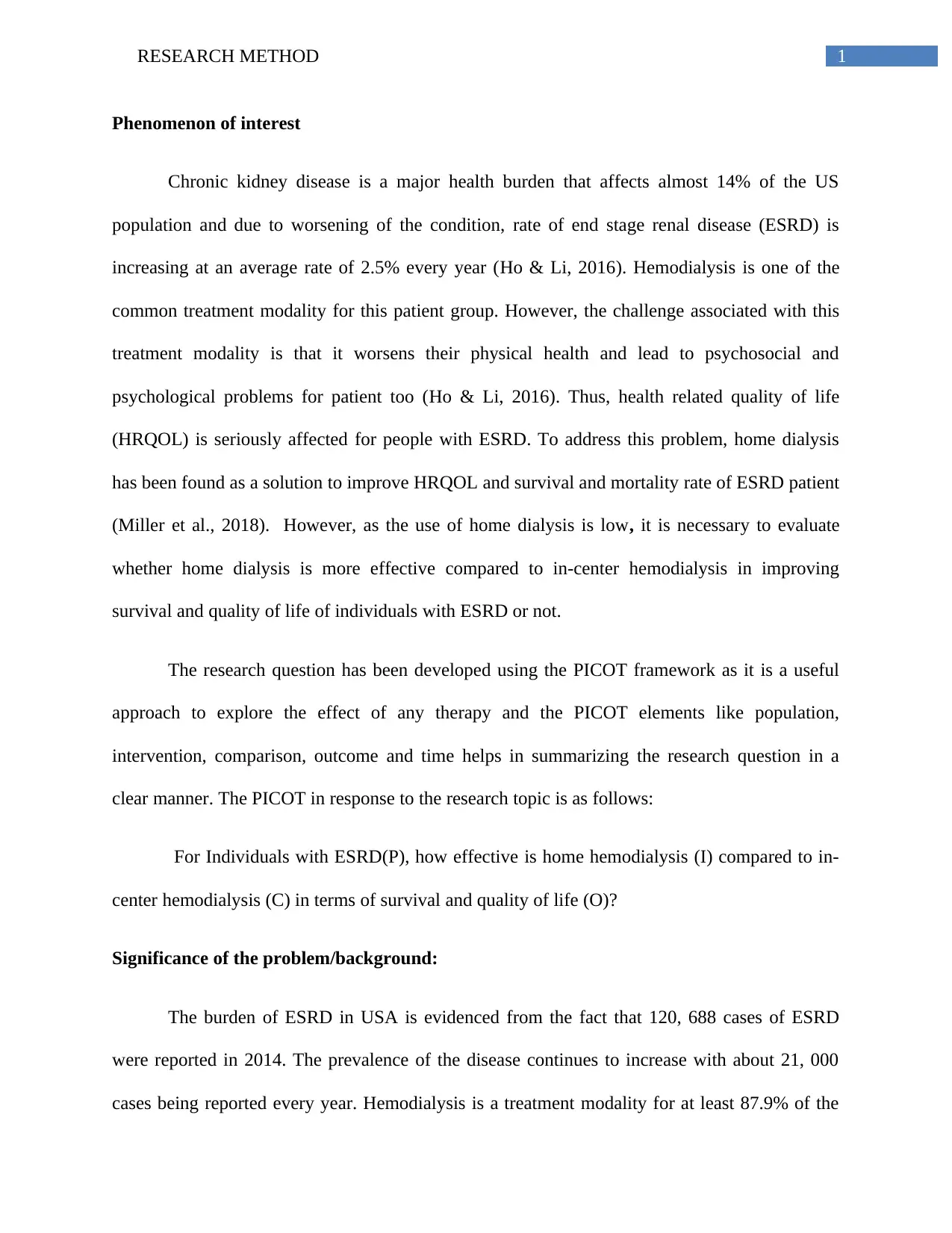
1RESEARCH METHOD
Phenomenon of interest
Chronic kidney disease is a major health burden that affects almost 14% of the US
population and due to worsening of the condition, rate of end stage renal disease (ESRD) is
increasing at an average rate of 2.5% every year (Ho & Li, 2016). Hemodialysis is one of the
common treatment modality for this patient group. However, the challenge associated with this
treatment modality is that it worsens their physical health and lead to psychosocial and
psychological problems for patient too (Ho & Li, 2016). Thus, health related quality of life
(HRQOL) is seriously affected for people with ESRD. To address this problem, home dialysis
has been found as a solution to improve HRQOL and survival and mortality rate of ESRD patient
(Miller et al., 2018). However, as the use of home dialysis is low, it is necessary to evaluate
whether home dialysis is more effective compared to in-center hemodialysis in improving
survival and quality of life of individuals with ESRD or not.
The research question has been developed using the PICOT framework as it is a useful
approach to explore the effect of any therapy and the PICOT elements like population,
intervention, comparison, outcome and time helps in summarizing the research question in a
clear manner. The PICOT in response to the research topic is as follows:
For Individuals with ESRD(P), how effective is home hemodialysis (I) compared to in-
center hemodialysis (C) in terms of survival and quality of life (O)?
Significance of the problem/background:
The burden of ESRD in USA is evidenced from the fact that 120, 688 cases of ESRD
were reported in 2014. The prevalence of the disease continues to increase with about 21, 000
cases being reported every year. Hemodialysis is a treatment modality for at least 87.9% of the
Phenomenon of interest
Chronic kidney disease is a major health burden that affects almost 14% of the US
population and due to worsening of the condition, rate of end stage renal disease (ESRD) is
increasing at an average rate of 2.5% every year (Ho & Li, 2016). Hemodialysis is one of the
common treatment modality for this patient group. However, the challenge associated with this
treatment modality is that it worsens their physical health and lead to psychosocial and
psychological problems for patient too (Ho & Li, 2016). Thus, health related quality of life
(HRQOL) is seriously affected for people with ESRD. To address this problem, home dialysis
has been found as a solution to improve HRQOL and survival and mortality rate of ESRD patient
(Miller et al., 2018). However, as the use of home dialysis is low, it is necessary to evaluate
whether home dialysis is more effective compared to in-center hemodialysis in improving
survival and quality of life of individuals with ESRD or not.
The research question has been developed using the PICOT framework as it is a useful
approach to explore the effect of any therapy and the PICOT elements like population,
intervention, comparison, outcome and time helps in summarizing the research question in a
clear manner. The PICOT in response to the research topic is as follows:
For Individuals with ESRD(P), how effective is home hemodialysis (I) compared to in-
center hemodialysis (C) in terms of survival and quality of life (O)?
Significance of the problem/background:
The burden of ESRD in USA is evidenced from the fact that 120, 688 cases of ESRD
were reported in 2014. The prevalence of the disease continues to increase with about 21, 000
cases being reported every year. Hemodialysis is a treatment modality for at least 87.9% of the
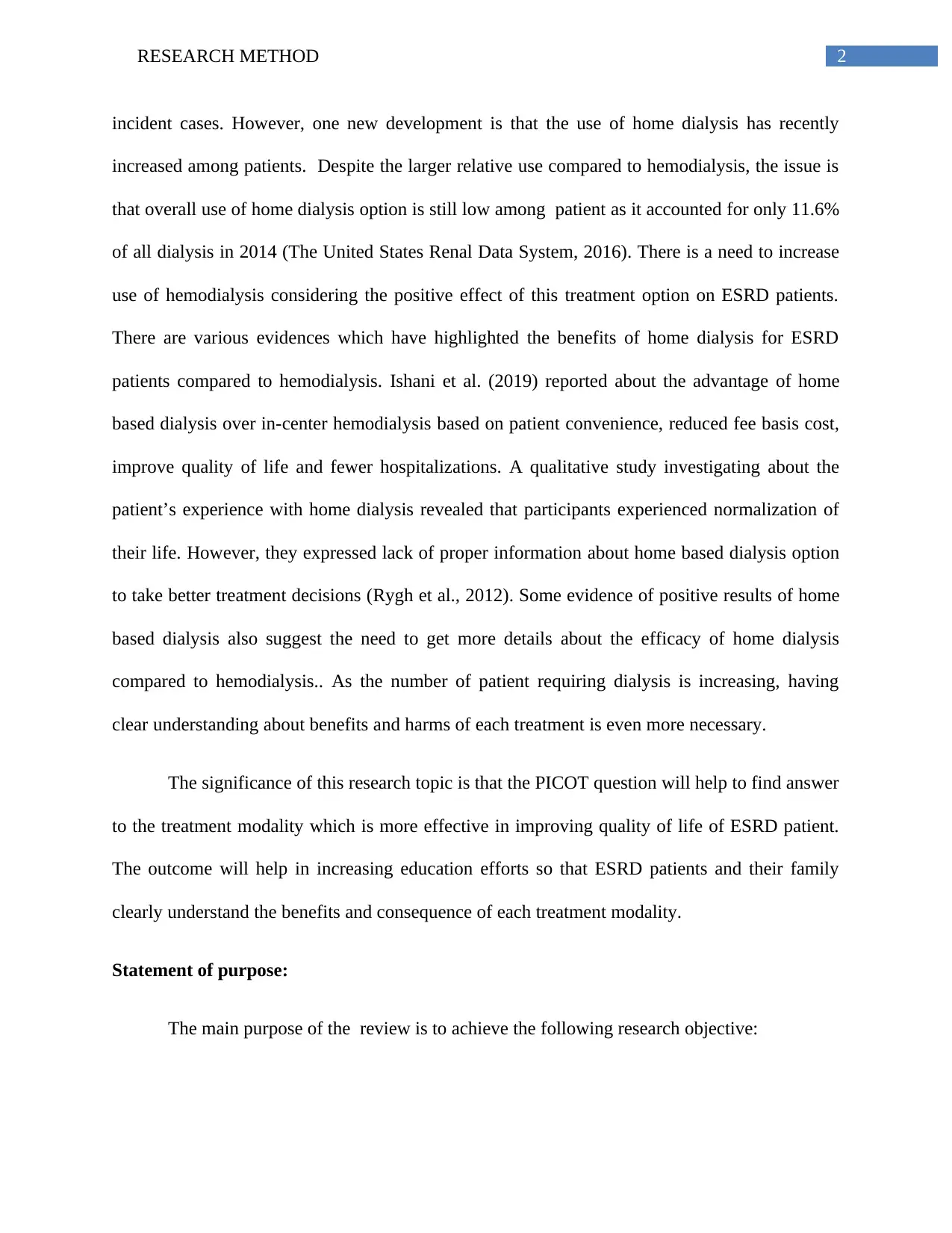
2RESEARCH METHOD
incident cases. However, one new development is that the use of home dialysis has recently
increased among patients. Despite the larger relative use compared to hemodialysis, the issue is
that overall use of home dialysis option is still low among patient as it accounted for only 11.6%
of all dialysis in 2014 (The United States Renal Data System, 2016). There is a need to increase
use of hemodialysis considering the positive effect of this treatment option on ESRD patients.
There are various evidences which have highlighted the benefits of home dialysis for ESRD
patients compared to hemodialysis. Ishani et al. (2019) reported about the advantage of home
based dialysis over in-center hemodialysis based on patient convenience, reduced fee basis cost,
improve quality of life and fewer hospitalizations. A qualitative study investigating about the
patient’s experience with home dialysis revealed that participants experienced normalization of
their life. However, they expressed lack of proper information about home based dialysis option
to take better treatment decisions (Rygh et al., 2012). Some evidence of positive results of home
based dialysis also suggest the need to get more details about the efficacy of home dialysis
compared to hemodialysis.. As the number of patient requiring dialysis is increasing, having
clear understanding about benefits and harms of each treatment is even more necessary.
The significance of this research topic is that the PICOT question will help to find answer
to the treatment modality which is more effective in improving quality of life of ESRD patient.
The outcome will help in increasing education efforts so that ESRD patients and their family
clearly understand the benefits and consequence of each treatment modality.
Statement of purpose:
The main purpose of the review is to achieve the following research objective:
incident cases. However, one new development is that the use of home dialysis has recently
increased among patients. Despite the larger relative use compared to hemodialysis, the issue is
that overall use of home dialysis option is still low among patient as it accounted for only 11.6%
of all dialysis in 2014 (The United States Renal Data System, 2016). There is a need to increase
use of hemodialysis considering the positive effect of this treatment option on ESRD patients.
There are various evidences which have highlighted the benefits of home dialysis for ESRD
patients compared to hemodialysis. Ishani et al. (2019) reported about the advantage of home
based dialysis over in-center hemodialysis based on patient convenience, reduced fee basis cost,
improve quality of life and fewer hospitalizations. A qualitative study investigating about the
patient’s experience with home dialysis revealed that participants experienced normalization of
their life. However, they expressed lack of proper information about home based dialysis option
to take better treatment decisions (Rygh et al., 2012). Some evidence of positive results of home
based dialysis also suggest the need to get more details about the efficacy of home dialysis
compared to hemodialysis.. As the number of patient requiring dialysis is increasing, having
clear understanding about benefits and harms of each treatment is even more necessary.
The significance of this research topic is that the PICOT question will help to find answer
to the treatment modality which is more effective in improving quality of life of ESRD patient.
The outcome will help in increasing education efforts so that ESRD patients and their family
clearly understand the benefits and consequence of each treatment modality.
Statement of purpose:
The main purpose of the review is to achieve the following research objective:
⊘ This is a preview!⊘
Do you want full access?
Subscribe today to unlock all pages.

Trusted by 1+ million students worldwide
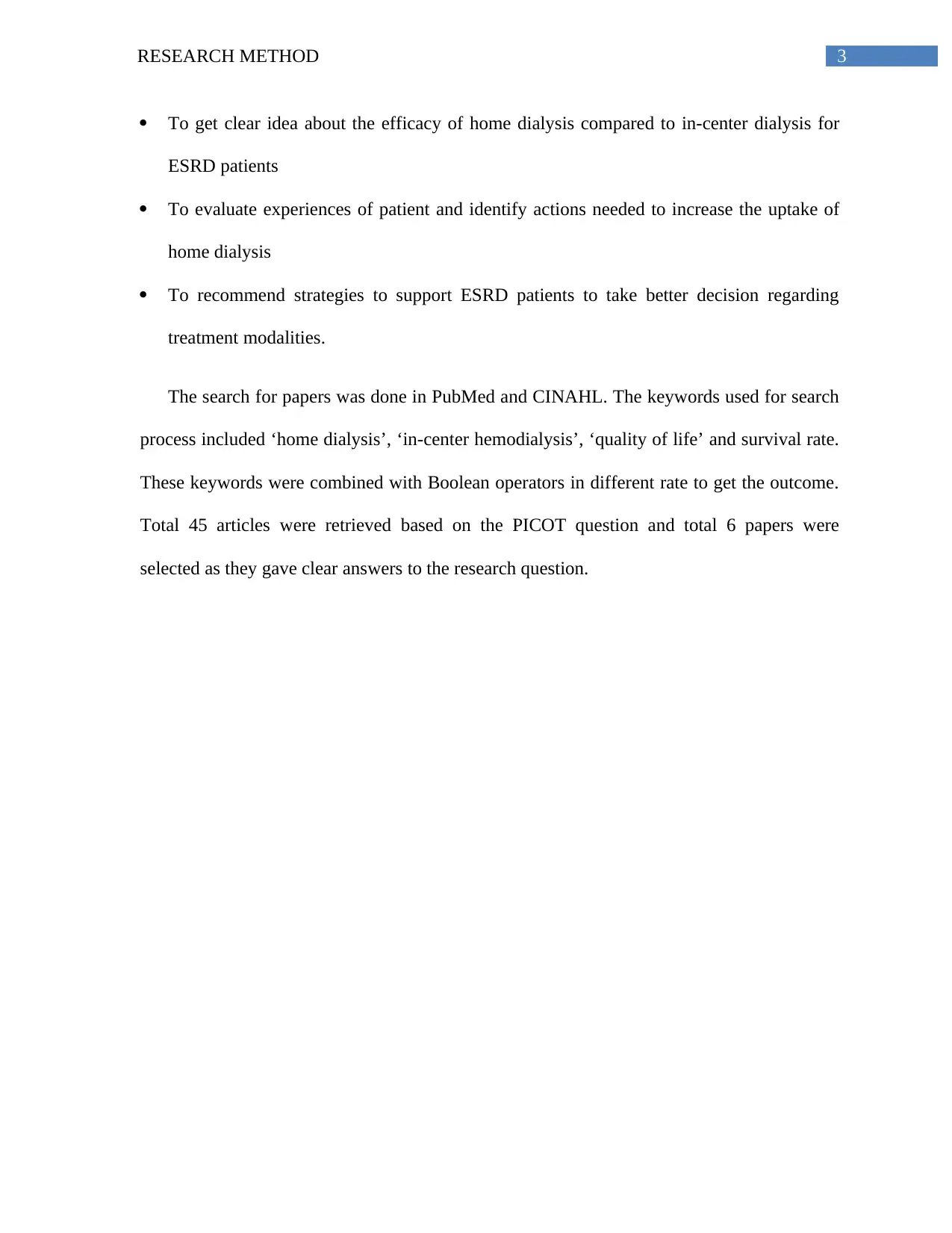
3RESEARCH METHOD
To get clear idea about the efficacy of home dialysis compared to in-center dialysis for
ESRD patients
To evaluate experiences of patient and identify actions needed to increase the uptake of
home dialysis
To recommend strategies to support ESRD patients to take better decision regarding
treatment modalities.
The search for papers was done in PubMed and CINAHL. The keywords used for search
process included ‘home dialysis’, ‘in-center hemodialysis’, ‘quality of life’ and survival rate.
These keywords were combined with Boolean operators in different rate to get the outcome.
Total 45 articles were retrieved based on the PICOT question and total 6 papers were
selected as they gave clear answers to the research question.
To get clear idea about the efficacy of home dialysis compared to in-center dialysis for
ESRD patients
To evaluate experiences of patient and identify actions needed to increase the uptake of
home dialysis
To recommend strategies to support ESRD patients to take better decision regarding
treatment modalities.
The search for papers was done in PubMed and CINAHL. The keywords used for search
process included ‘home dialysis’, ‘in-center hemodialysis’, ‘quality of life’ and survival rate.
These keywords were combined with Boolean operators in different rate to get the outcome.
Total 45 articles were retrieved based on the PICOT question and total 6 papers were
selected as they gave clear answers to the research question.
Paraphrase This Document
Need a fresh take? Get an instant paraphrase of this document with our AI Paraphraser
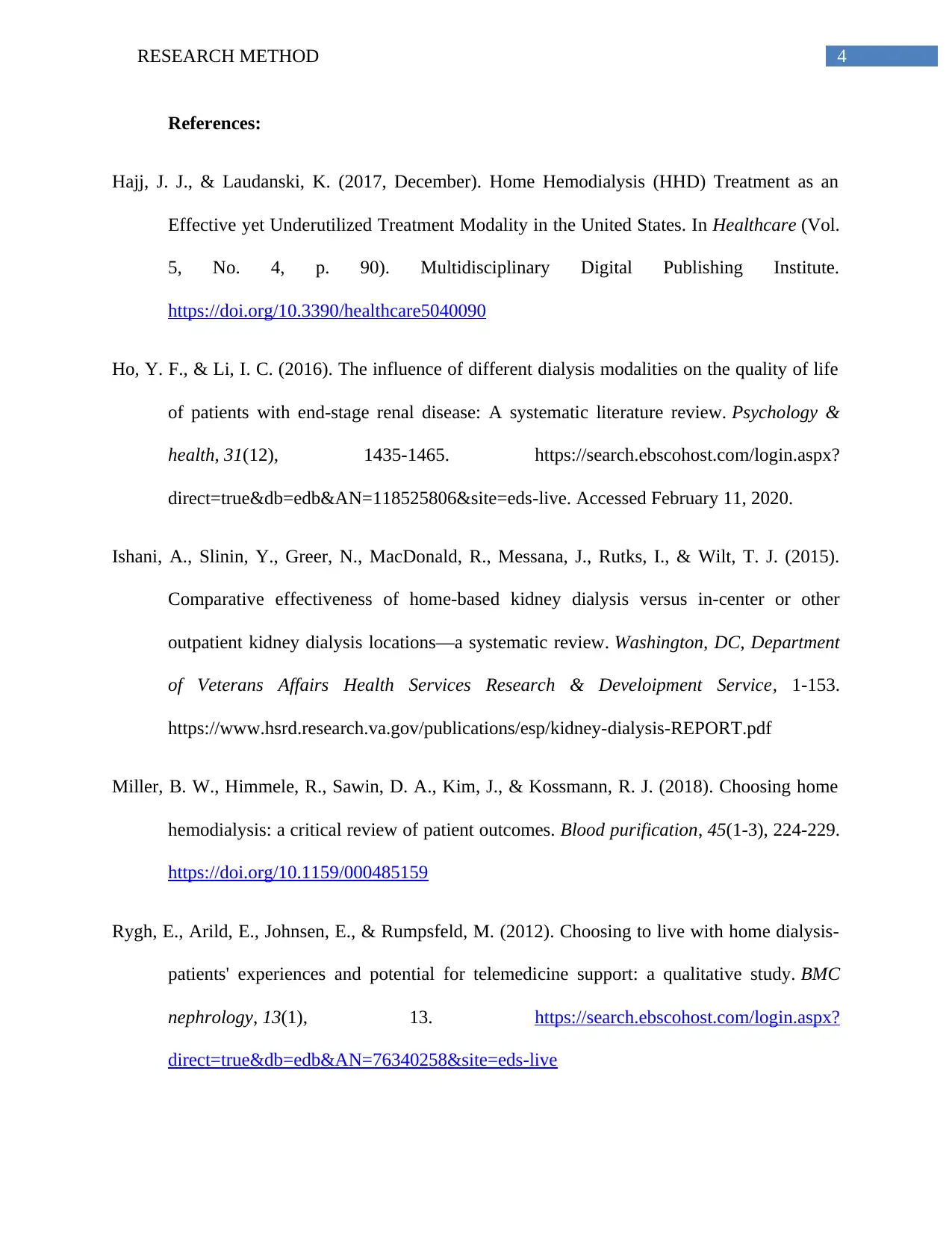
4RESEARCH METHOD
References:
Hajj, J. J., & Laudanski, K. (2017, December). Home Hemodialysis (HHD) Treatment as an
Effective yet Underutilized Treatment Modality in the United States. In Healthcare (Vol.
5, No. 4, p. 90). Multidisciplinary Digital Publishing Institute.
https://doi.org/10.3390/healthcare5040090
Ho, Y. F., & Li, I. C. (2016). The influence of different dialysis modalities on the quality of life
of patients with end-stage renal disease: A systematic literature review. Psychology &
health, 31(12), 1435-1465. https://search.ebscohost.com/login.aspx?
direct=true&db=edb&AN=118525806&site=eds-live. Accessed February 11, 2020.
Ishani, A., Slinin, Y., Greer, N., MacDonald, R., Messana, J., Rutks, I., & Wilt, T. J. (2015).
Comparative effectiveness of home-based kidney dialysis versus in-center or other
outpatient kidney dialysis locations—a systematic review. Washington, DC, Department
of Veterans Affairs Health Services Research & Develoipment Service, 1-153.
https://www.hsrd.research.va.gov/publications/esp/kidney-dialysis-REPORT.pdf
Miller, B. W., Himmele, R., Sawin, D. A., Kim, J., & Kossmann, R. J. (2018). Choosing home
hemodialysis: a critical review of patient outcomes. Blood purification, 45(1-3), 224-229.
https://doi.org/10.1159/000485159
Rygh, E., Arild, E., Johnsen, E., & Rumpsfeld, M. (2012). Choosing to live with home dialysis-
patients' experiences and potential for telemedicine support: a qualitative study. BMC
nephrology, 13(1), 13. https://search.ebscohost.com/login.aspx?
direct=true&db=edb&AN=76340258&site=eds-live
References:
Hajj, J. J., & Laudanski, K. (2017, December). Home Hemodialysis (HHD) Treatment as an
Effective yet Underutilized Treatment Modality in the United States. In Healthcare (Vol.
5, No. 4, p. 90). Multidisciplinary Digital Publishing Institute.
https://doi.org/10.3390/healthcare5040090
Ho, Y. F., & Li, I. C. (2016). The influence of different dialysis modalities on the quality of life
of patients with end-stage renal disease: A systematic literature review. Psychology &
health, 31(12), 1435-1465. https://search.ebscohost.com/login.aspx?
direct=true&db=edb&AN=118525806&site=eds-live. Accessed February 11, 2020.
Ishani, A., Slinin, Y., Greer, N., MacDonald, R., Messana, J., Rutks, I., & Wilt, T. J. (2015).
Comparative effectiveness of home-based kidney dialysis versus in-center or other
outpatient kidney dialysis locations—a systematic review. Washington, DC, Department
of Veterans Affairs Health Services Research & Develoipment Service, 1-153.
https://www.hsrd.research.va.gov/publications/esp/kidney-dialysis-REPORT.pdf
Miller, B. W., Himmele, R., Sawin, D. A., Kim, J., & Kossmann, R. J. (2018). Choosing home
hemodialysis: a critical review of patient outcomes. Blood purification, 45(1-3), 224-229.
https://doi.org/10.1159/000485159
Rygh, E., Arild, E., Johnsen, E., & Rumpsfeld, M. (2012). Choosing to live with home dialysis-
patients' experiences and potential for telemedicine support: a qualitative study. BMC
nephrology, 13(1), 13. https://search.ebscohost.com/login.aspx?
direct=true&db=edb&AN=76340258&site=eds-live

5RESEARCH METHOD
The United States Renal Data System. (2016). Incidence, Prevalence, Patient Characteristics,
and Treatment Modalities. Available online:
https://www.usrds.org/2016/view/v2_01.aspx
The United States Renal Data System. (2016). Incidence, Prevalence, Patient Characteristics,
and Treatment Modalities. Available online:
https://www.usrds.org/2016/view/v2_01.aspx
⊘ This is a preview!⊘
Do you want full access?
Subscribe today to unlock all pages.

Trusted by 1+ million students worldwide
1 out of 6
Related Documents
Your All-in-One AI-Powered Toolkit for Academic Success.
+13062052269
info@desklib.com
Available 24*7 on WhatsApp / Email
![[object Object]](/_next/static/media/star-bottom.7253800d.svg)
Unlock your academic potential
Copyright © 2020–2025 A2Z Services. All Rights Reserved. Developed and managed by ZUCOL.




